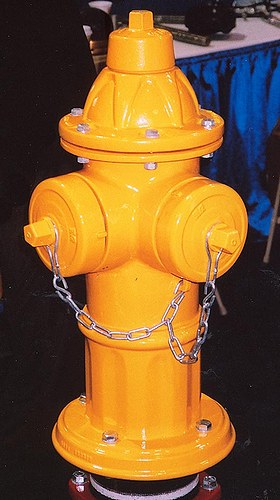| Double Steamer Hydrants |
|
|
|
 |
On mains with high fire flows, why restrict hydraulically efficient
discharges to one engine per hydrant? The double steamer allows two large diameter supply lines to be run from one hydrant to two separate pumping engines at the scene, or for
two separate pumping engines to pump directly from a single hydrant.
Some of these hydrants flow 3,000 GPM or more. Why would someone want
to lay a supply line several hundred feet from another hydrant when the
closest hydrant can supply more than one engine?
The weakness with "traditional" hydrants having a single pumper outlet and one or more hose outlets is that the second pumping engine has to take water from a smaller discharge opening. In a major fire, as the residual pressure in the hydrant (and/or main) starts to drop, that second engine may experience a loss of adequate supply due to the smaller hydrant discharge opening. There are ways to compensate for this problem (see the feature entitled "Achieving Maximum flow from Hydrants") but by far the simplest is to have the most efficient openings on the hydrant to begin with.
Q: If double pumper hydrants cost about the same as the
traditional 2 hose ports A: I think the word "traditional" is the most logical explanation. Q: If not system wide, could agencies use double steamer hydrants to advantage in certain situations --- industrial parks, downtown, etc.? A: This is what cities such as Stockton and Sacramento, California, have done. Here's the down side to double steamers. If someone wants to hook up a hydrant meter or a 2½" hose line to a hydrant they will have to also use a reducer. Not really a big deal but it is necessary... unless the hydrant is a double steamer plus a 2½ such as can be found in places like San Diego and a few other southern California cities.
Willis Lamm, Water Supply Officer (RET) |
Questions? or Comments?
Unless otherwise noted, all contents of these WWW pages © FireHydrant.org

